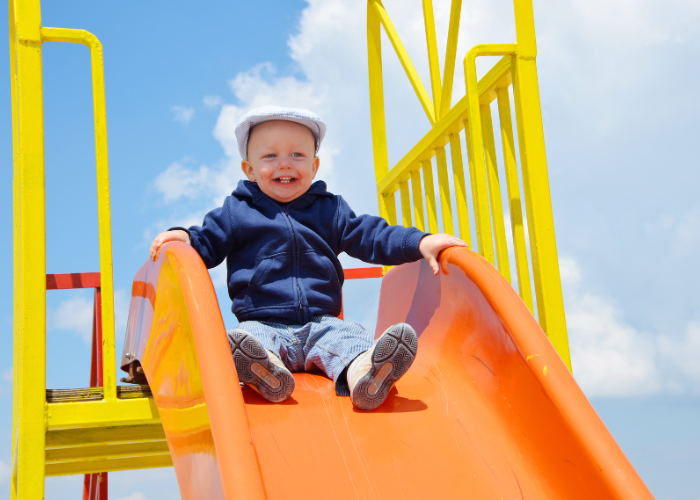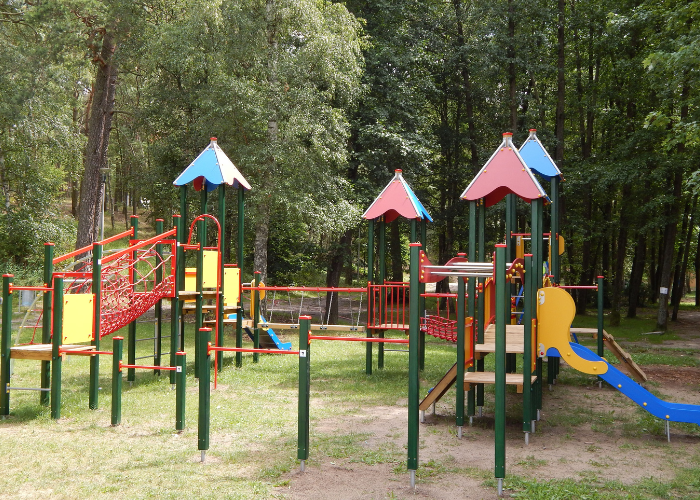Playground Maintenance & Repairs: Your Questions Answered
Playground maintenance is one of the most important aspects of owning and operating a playground.
As a playground owner or manager, you are responsible for ensuring your playground meets safety standards and remains in good working condition once it’s been installed. This includes regularly inspecting all equipment, keeping accurate maintenance records, and addressing any issues promptly.
If you don’t maintain your playground properly, it could lead to serious injuries and costly repairs.
Not only that, but a poorly looked after playground isn’t nearly as inviting as one that’s well-maintained. Children most certainly won’t want to play on equipment that’s broken or unsafe.
Contact Us to Discuss a Playground Inspection
What Does Playground Maintenance Involve?
Playground maintenance primarily involves three main factors. These steps help to ensure the playground remains a safe and enjoyable space for children and families.
1. Cleaning
Cleaning is the basic and essential step to keep the playground hygienic and looking good. This involves picking up litter, sanitising surfaces, and managing waste bins to stop germs from spreading and to keep the area visually appealing.
|
Read more: Why is Playground Cleaning Important? |
2. Routine Maintenance
Maintenance means regularly checking and taking care of playground equipment to ensure smooth and safe operation. This includes:
- Lubricating moving parts
- Tightening bolts and screws
- Applying protective coatings to surfaces
3. Check for Broken Parts & Vandalism
Regularly checking for broken parts and vandalism is key to maintaining a safe and inviting playground. Broken parts can be serious hazards, increasing the risk of accidents. Therefore, inspect all equipment thoroughly for cracks, sharp edges, or any damage.
Vandalism, like graffiti or damaged equipment, affects both the playground’s appearance and safety. During regular maintenance, look for signs of vandalism, which might not be obvious.
4. Organise Repairs Quickly
Quickly organising repairs is key to keeping the playground safe and usable. Fast repairs stop small problems from becoming bigger, more expensive ones, ensuring the playground stays safe for children.
Acting quickly reduces equipment downtime, keeping the playground open and enjoyable for the community. Timely repairs also keep the playground looking good, encouraging ongoing use and community involvement.
Addressing repairs as soon as they arise shows a commitment to safety and building trust and confidence among parents and caregivers.
|
Huck Play can assess Huck Play equipment and repair it where necessary. Give our team a call today for more information! |
Why is Routine Playground Maintenance Essential?
Maintaining a routine for playground maintenance is essential for several reasons.
First and foremost, it ensures the safety and well-being of the children who use the playground, as regular upkeep helps prevent accidents caused by faulty or damaged equipment.
Additionally, ongoing maintenance can extend the lifespan of the playground, reducing the need for costly replacements or repairs over time.
Consistent care also keeps the playground inviting and appealing, encouraging regular use by the community.
This, in turn, supports the physical and social development of children as they engage in outdoor play. Ultimately, routine maintenance contributes to a safe, functional, and enjoyable environment for all users.
How Often Should Playground Maintenance Be Done?
Playground maintenance should be carried out regularly to ensure safety and longevity beyond the annual inspection.
| Frequency | Description |
| Monthly | Thorough inspection for wear and tear, vandalism, and other emerging issues. |
| Weekly | Surface cleaning and removal of litter or debris. |
| Daily (for high-use playgrounds) | Inspection of equipment for safety and functionality, focusing on areas prone to wear (e.g., moving parts on swings and slides). |
By embedding these routine tasks into playground management, issues can be addressed promptly, maintaining a safe and welcoming environment year-round.
What Do Playground Inspections Include?
Professional playground project inspections often encompass a comprehensive evaluation of several key areas to ensure the safety and functionality of the playground:
| Inspection Area | Description |
| Structural Integrity | Checks stability, durability, foundations, connections, and supports for security and collapse prevention. |
| Surface Conditions | Assesses wear, proper installation, and compliance with safety standards for fall cushioning. |
| Compliance with Safety Standards | Verifies adherence to British and European Standards (BS EN 1176 and 1177) for equipment specifications and installation. |
| Wear and Tear | Examines all equipment for wear, rust, corrosion, sharp edges, and high-usage areas. |
| Functionality of Moving Parts | Checks the condition and operation of hinges, joints, swivels, ropes, and other moving parts for proper function. |
| Safety Features | Evaluate guardrails, protective barriers, and signage for integrity and compliance with safety standards. |
| Vandalism and Damage | Identifies deliberate damage or vandalism, recommending repairs or replacements. |
| General Cleanliness and Maintenance | Notes overall cleanliness and maintenance issues like litter or debris. |
You can find more information about your responsibilities and requirements for playground inspections with our Playground Equipment Maintenance Guide.
The Legalities of Playground Maintenance & Repairs
In the UK, playground owners and management companies must legally ensure their playgrounds meet specific safety standards.
Laws like the Health and Safety at Work Act 1974 and the Management of Health and Safety at Work Regulations 1999 require regular inspections, prompt hazard addressing, and safe equipment for public use.
Not following these rules can endanger users and lead to legal issues or even closure of the playgrounds.
| Legislation | Description |
| Health and Safety at Work Act 1974 | The foundational legislation for workplace safety, ensuring that work environments, including playgrounds, are safe and free from health risks. |
| Management of Health and Safety at Work Regulations 1999 | Provides detailed guidelines on risk assessments and implementing health and safety measures. |
| Occupiers' Liability Act 1957 & 1984 | Outlines responsibilities of property owners to ensure reasonable safety for visitors. |
| Children’s Act 1989 | Establishes safeguarding requirements for children, including play environments. |
| British and European Standards (BS EN 1176 and 1177) | These standards provide safety guidelines for playground equipment and surfacing to reduce injury risks. Adherence is recommended for all playground operators. |
*Although not legal requirements, adherence to these standards for playground equipment and surfacing is highly recommended. All Huck Play equipment adheres to these standards.
How Can Playground Equipment Be Repaired?
Repairing playground equipment involves several steps to ensure safety and functionality are restored effectively.
Initially, identify any damaged or worn-out parts through a thorough inspection. Next, acquire the necessary tools and materials, using replacement parts that meet safety standards like BS EN 1176.
For minor repairs, such as tightening loose bolts or replacing worn swing seats, maintenance personnel can often handle the task.
|
However, significant structural damage or complex issues require professional repair services to ensure proper fixes are made. |
It's essential to document all repairs, maintaining a record of the work done to comply with safety regulations and standards.
Regularly scheduled maintenance should also be implemented to prevent future issues. Whether seeking professional help or conducting repairs in-house, prioritising safety and compliance is crucial throughout the process.
Huck Play’s Playground Repair Service
At Huck Play, we offer a comprehensive professional playground assessment and repair service tailored specifically for all Huck Play equipment.
Our expert team conducts detailed assessments to identify any areas that may require attention, ensuring your playground remains safe, compliant, and operational.
We use high-quality replacement parts adhering to BS EN 1176 standards, guaranteeing durability and safety. Whether it's minor fixes or more complex repairs, our skilled technicians are equipped to address any issue efficiently.
Entrust your playground to us for impeccable maintenance and repairs, ensuring a secure and enjoyable play environment for all.
What Are the Best Practices for Seasonal Playground Maintenance?
Seasonal playground maintenance is essential for ensuring that equipment remains safe and functional throughout the year.
Best practices involve adjusting maintenance routines to account for the varying weather conditions associated with different seasons.
- In spring, focus on checking for and repairing any damage caused by winter weather, such as rust or loosened fixtures.
- Summer requires frequent checks for overheating and UV damage, particularly on ground coverings and materials that may become too hot for children to touch.
- Autumn is an optimal time to clear fallen leaves and prepare equipment for harsher weather conditions.
- Winter maintenance should include ensuring all equipment can withstand cold temperatures, ice, or snow.
Regularly updating maintenance schedules and performing detailed inspections at the change of each season will help identify potential issues early, promote safety, and extend the lifespan of the playground equipment.
Tips for Community-Driven Playground Maintenance
Community-driven playground maintenance involves engaging local residents in the upkeep of their play areas, fostering a sense of responsibility and ownership. Here are some tips to initiate and sustain a successful community effort:
- Organise Regular Volunteer Days: Host scheduled clean-up and maintenance events, inviting community members to participate. Providing necessary tools and refreshments can encourage higher turnout.
- Establish a Community Group: Create a dedicated group or committee responsible for coordinating maintenance activities. This group can serve as the point of contact for all playground-related concerns. Social media such as Facebook is great for this!
- Provide Education and Training: Offer workshops or resources to educate volunteers on basic maintenance tasks, safety standards, and how to identify potential hazards.
- Utilise Social Media: Use local social media groups or pages to share updates, schedules, and maintenance tips. Engaging the community online can increase awareness and participation.
- Encourage Feedback: Set up a suggestion box or online survey to gather input from playground users on needed playground improvements or areas of concern. This ensures the maintenance efforts align with community needs.
- Work with Local Businesses: Partner with local suppliers and businesses to obtain discounts on materials or sponsorships to support maintenance activities.
By leveraging the community's collective efforts, regular maintenance and improvements can not only keep playgrounds safe and enjoyable but also strengthen community bonds.
Key Takeaways: Maintaining a Safe Playground
Safety really is at the forefront of a great playground.
Regular maintenance and prompt repairs are crucial in ensuring safety for playground users. Make sure to do your part by reporting any issues to the appropriate authorities and staying informed about playground safety guidelines.
With these measures in place, we can all work together to maintain safe and enjoyable playgrounds for years to come.
For any advice or requests on maintaining and repairing your Huck Play structures, please do give us a call or send us an email. Our team of experts is always happy to assist and ensure that your playground remains a safe and fun place for all.
FAQs
How Often Should Playground Refurbishment Be Carried Out?
Playground refurbishment should be carried out every 10-15 years, depending on wear and tear, frequency of use, and environmental factors. Regular inspections ensure minor repairs are made promptly, prolonging the playground's life and maintaining a safe play environment.
Who is Responsible for Playground Maintenance?
Playground maintenance is the responsibility of the owner, typically schools, local councils, or community organisations. They must ensure routine inspections and timely repairs to maintain safety standards, prolong equipment life, and provide a secure and enjoyable play environment.
Are Playground Inspections a Legal Requirement?
Yes, playground inspections are legally required to ensure compliance with safety standards and regulations. They help prevent accidents, ensure equipment reliability, and maintain a safe environment for children, making it essential for playground owners to conduct regular check-ups.










